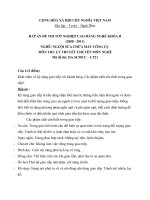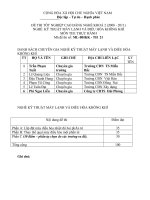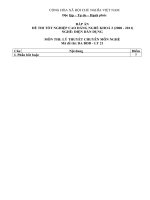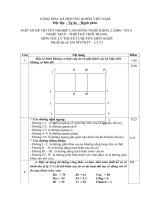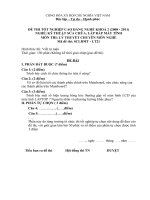- Trang chủ >>
- THPT Quốc Gia >>
- Ngoại Ngữ
E9 Week 21
Bạn đang xem bản rút gọn của tài liệu. Xem và tải ngay bản đầy đủ của tài liệu tại đây (204.48 KB, 4 trang )
<span class='text_page_counter'>(1)</span>Week: 21 Period: 41. Date of preparing: 10/ 01/ 2017 Date of teaching: 12/ 01/ 2017. UNIT 6: THE ENVIRONMENT Lesson 3: READ I. OBJECTIVES: Teaching aims: By the end of the lesson, Ss will practice reading a poem for details about the environment. II. PREPARATIONS: book, extra – board III. PROCEDURES: *Checking attendance (1’): - 9A1:………………………………………………… - 9A2:………………………………............................ Teacher’s activities 1. Warm - up (7’) - Ask Ss some questions: + Do you like poetry? + Which poet do you like best? + What are your favorite poems? + Do you think it is easy to understand a poem? + Have you ever an English poem? + Do you like it? 2. Pre - reading (10’) - Introduce the poem: a mother and a son are having a picnic. The son sees that the place is polluted. He asks his mother about the problems of pollution. - Introduce some new words. 1. End – up (v) 2. Second – hand (n) 3. Junk-yard (n) 4. Treasure (n) 5. Hedge (n) 6. Nonsense (n) 7. Foam (n) - Have Ss practice new words. - Ask some questions 1. Where are the mother and the son? 2. What does the son ask his mother? 3. What problem of the environment is mentioned in the poem? 3. While - reading (17’) - Guide Ss to read the poem (1-2/3-4-5-6/7-8/9-10/1112/13-14-15-16) - Call some Ss to read aloud. - Have Ss read the text and answer the questions above. Students’ activities - Answer the questions. - Listen - Write down.. - Practice the new words. - Guess the answer.. - Listen. - Read the poem. - Read silently and check the answers.
<span class='text_page_counter'>(2)</span> - Pair works. - Have Ss read the text again and match column A with column B(page 51) - Give the answer. - Get feedback Answer key: 1-c, 2-g, 3-f, 4-e, 5-d, 6-a, 7-b - Group work. - Have Ss answer the questions in group. - Give the answer - Get feedback Answer key a) If the pollution goes on, the world will end up like a second hand junk-yard. b) The mother thinks other folk pollute the environment not her not her son. c) His mother will take him home right away. d) No, he’s right. If he throws the bottles that will be polluting the woods. e) The poet wants us to learn that everyone is responsible for keeping the environment from pollution. 4. Post - speaking (8’) - Have Ss discuss the question - Wok in group to discuss the What should you do to keep your hometown clean? question - Get feedback - Give the answer. 5. Homework (2’) - Ask Ss to: Take note + Write the answers in their notebook. + Prepare the next lesson: Unit 6: Write/ p. 52 IV. COMMENTS: ........................................................................................................................................................... ........................................................................................................................................................... __________________________________ __________________________________ Week: 21 Date of preparing: 12/ 01/ 2017 Period: 42 Date of teaching: 14/ 01/ 2017. UNIT 6: THE ENVIRONMENT Lesson 4: WRITE I. OBJECTIVES: Teaching aims: By the end of the lesson, students will practice writing a letter of complaint. II. PREPARATIONS: book, extra – board III. PROCEDURES: *Checking attendance (1’): - 9A1:………………………………………………… - 9A2:………………………………............................ Teacher’s activities 1. Warm – up: (5’) - Have Ss look at the pictures and give the problems. Students’ activities - Give the answer..
<span class='text_page_counter'>(3)</span> 2. Pre - writing (15’) - Introduce the format of a complaint letter. 1. Situation: states the reason for writing 2. Complication: mentions the problem 3. Resolution: makes suggestion 4. Action: talks about future action 5. Politeness: ends the letter politely - Introduce Mr.Nhat’s letter and explain some new words. 1. Clear up (v) 2. Refreshment (n) * suggest + S + should - Have Ss read Mr. Nhat’s letter and label each section with appropriate letter: S, C, R, A, P - Call Ss to get feedback - Have Ss read the production 6b/53: These days, many people begin to catch fish in the lake behind your house. What makes you worried most is they use electricity to catch fish. A lot of fish died and floated on the water surface. Other animals such as frogs, toads, and even birds also died from electric shock waves. You think that local authorities should prohibit and fine heavily anyone catching fish in this way - Have Ss answer some questions: 1. What do people do in the lake behind your house? 2. What makes you worried? 3. To whom do you write the letter to? What suggestion do you want to make? 4. Any future plan do you want to make? 3. While - writing (17’) - Have Ss base on the answers to write a complaint letter with the situation. * Suggested idea: Dear Mr. President, I am writing to you about the problem of fish catching in the lake behind my house. I am very worried because people use electricity to catch fish. After a short time they left the place/ lake a lot of small fish died and floated on the water surface. Other animals such as frogs, toads and even birds also died from electric shock waves. I would suggest the local authorities should prohibit and fine heavily anyone using this way of catching fish.. - Write down.. - Listen. - Read, work in pair to label - Key: R, S, A, C, P - Read the situation.. - Answer the questions. - Work individually.
<span class='text_page_counter'>(4)</span> I look forward to hearing from you and seeing the protection of environment from the local authority. Your faithfully, 4. Post - writing (5’) - Have Ss exchange their writing and call Ss to read aloud - Work in pair. their letter - Correct mistakes - Listen. 5. Homework (2’) - Ask Ss to: + Write the completed letter again in their notebook + Prepare the next period: Lesson 5: Language Focus - Take note IV. COMMENTS: ........................................................................................................................................................... ........................................................................................................................................................... _________________________________ ___________________________________.
<span class='text_page_counter'>(5)</span>


